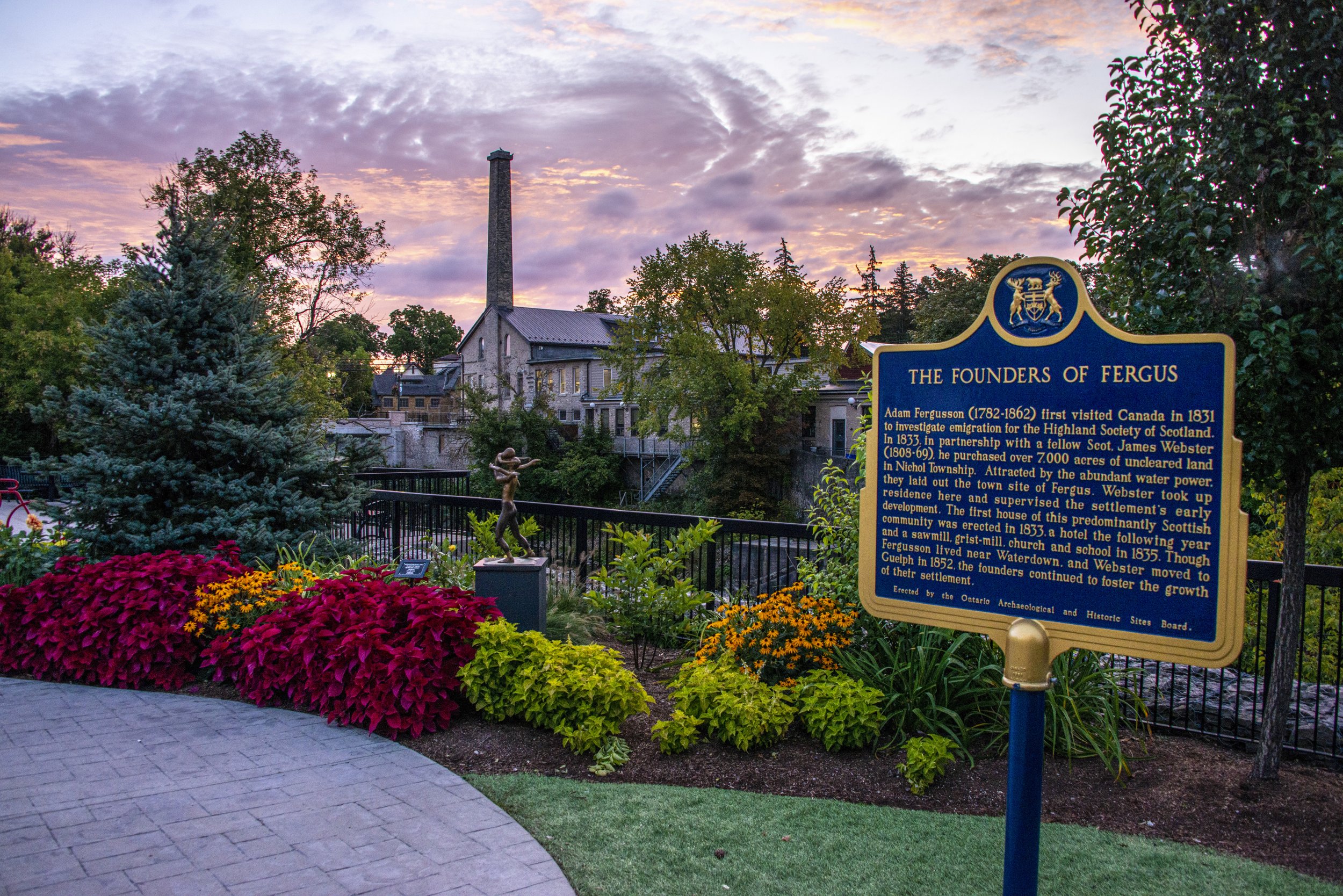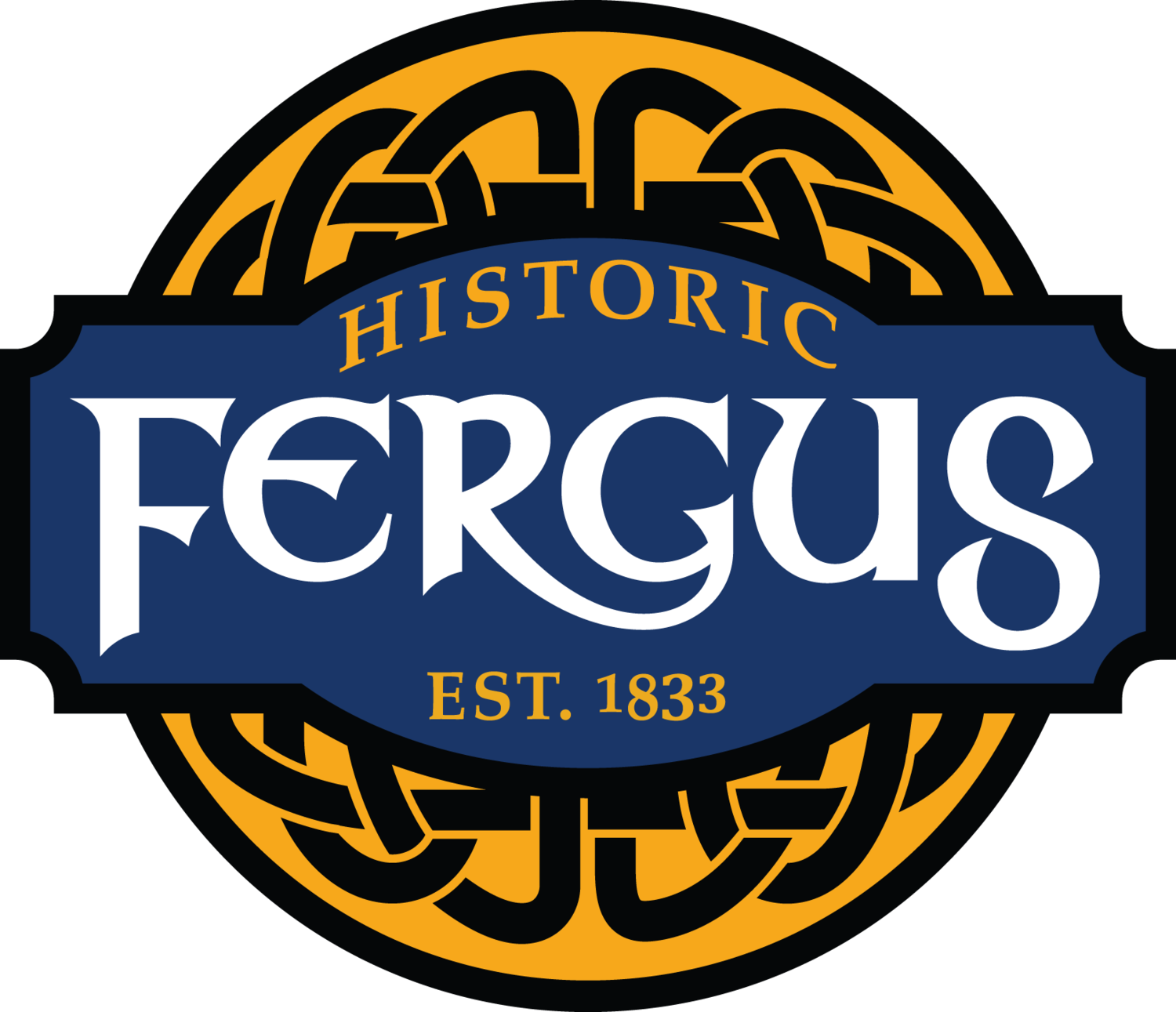
Located on the Grand River, Fergus was founded by Adam Ferguson in 1833 who, along with fellow lawyer James Webster, bought 7,000 acres of land and began developing the area. The first house was built in 1833. A hotel followed in 1834 and by 1835 the town had a tavern, grist-mill, church and a school.

212 St. Andrew St. W
Built in 1872, this building was home to John Thomson and Son Furniture and Funeral Business. John Thomson was a local carpenter and cabinet maker by trade, and entered the funeral business when he was asked to make coffins as well.
The picture clearly illustrates the duality of the Thomson business which provided both furnishings and funerals. John Thomson and Son was the largest furniture and picture framing business in the area and kept a large stock of superior furniture, upholstered goods, wallpaper, and window blinds; furnishing many of the best residences and buildings in Fergus and area.
The glass enclosed horse-drawn hearse reveals the Funeral & Undertaking side of the business provided by John Thomson and Son. In 1874, the two horses draped in black fringe would draw the hearse in the funeral procession to the cemetery for a charge of $11.50, which included the cost of the coffin.
This building with its stone foundation and board and batten siding is a good example of a typical false front commercial building from the late 1800s. The false front wall extends above the roof and the sides of the building to create a more impressive facade. This style of building was used to give a more prosperous and established appearance to commercial buildings. From the picture it can be seen that at some point the original facade was covered over by cedar shingles.
Following a long history as a furniture warehouse and funeral parlour, this property was sold in 1910 and became The Fergus Pool Room where it enjoyed the reputation as the local “hang-out” for well over 50 years. At some point during this time period, the concrete block back section of the building was added, and more recently the building has returned to retail uses. Being located in the heart of downtown Fergus, 212 St. Andrew St West still enjoys a reputation as a community hub and gathering place.
Templin Gardens
Tucked quietly in the heart of downtown Fergus and perched on the edge of the gorge, you will find Templin Gardens. Templin Gardens was commissioned in the late 1920s by J.C.Templin who was the editor of the Fergus News Record. The loving gesture was a gift to his wife and ultimately to all who have had the pleasure of visiting here.
The Gardens began as a vacant lot on the south side of St Andrew St and took nearly 10 years to construct. Due to the Depression, local skilled labour was available, Using stone from the nearby Gow limestone quarry, they gave Templin Gardens the distinctive mark of Scottish stone masons from a bygone era.
Templin Gardens grew in size and stature from its humble beginnings. The entrance was directly from St Andrew St through an elaborate wrought iron gate. There were green lawns, benches, meandering flagstone walkways, birdhouses, bird baths, a sundial, arbours, and a wide assortment of flowers and trees. A feature of the gardens was a fish pond with a statue of Pan with water falling over a waterfall and into the gorge. The stone stairway to the river’s edge afforded a breathtaking view of the rapids and gorge.
Sadly, over time the Gardens fell into disrepair and a portion of the property was sold. Thankfully, a restoration project initiated by the Fergus Chamber of Commerce took place in the 1970s and the lower level of the original garden was restored. What remains today gives us a glimpse of its original size and grandeur, but its beauty and charm remain. The Fergus Horticultural Society volunteers maintain and care for Templin Gardens.
The Kissing Stane
This large granite stone or stane was uncovered in the 1830s when the forest below St. Andrew’s Presbyterian Church was first cleared. The area was named James Squarein honour of James Webster who, along with Adam Fergusson, founded the new settlement. To the early Scottish masons the rock was a type of very hard granite known as blue hardhead. Children called the boulder “Castle Stane” mounting it as they played a variety of improvised games. One of those pioneer children, James Black Perry, later wrote a poem about it:
With the Square’s steep slope, its initial use as the village fairgrounds was short-lived nevertheless, it afforded a lovely view of the river and continued to be a popular gathering spot. Around 1870 a bandstand was built near the stone and it became a favourite lingering place for young Victorian couples. According to local legend it was the one location in Fergus where public displays of affection were tolerated and soon became known as the “Kissing Stane”. Many townsfolk claimed that to be kissed while seated on the stone would inevitably bring good luck.
Early in the 20th century plans were made to replace the old bandstand with a new one. In preparing for this project several workers decided that it would be a good idea to blast the stone away using dynamite. Although the plan was foiled, drill holes for the dynamite can still be seen in the rock. The bandstand is long gone and the “Kissing Stane”, largely forgotten, slumbers near the western edge of old James Square.
The Grand Theatre
A part of the community since 1928, the historic Fergus Grand Theatre has changed hands and uses over the years, but has never lost sight of its purpose of providing community entertainment.
The Fergus Grand Theatre was the dream of Sam Fardella, who turned the site of an old barn into a theatre on the main street of Fergus. On August 28, 1928, Louis B. Mayer, the head of MGM in Hollywood, sent Sam best wishes by telegram on the Grand Theatre's opening night.
Throughout the 1930's, 40's and 50's the Grand Theatre presented not only movies but also plays, concerts and other live events. With the rise of drive-ins and television in the late 50's and early 60's the theatre's popularity started to dwindle.
Cable television pioneer Jake Milligan bought the building in the late 1960's to house the rapidly growing Fergus-Elora Cable TV, as well as an electronics store. Live performances returned in the early 1980's with shows produced by the Elora Community Theatreand other local and regional theatre companies.
Hugh and Lorraine Drew-Brook bought the building in the early 1990's and a professional summer theatre started in 1993. Theatre on the Grand came to an end in the summer of 2003 and the building then became the property of the Township of Centre Wellington.
Today the Fergus Grand Theatre has one full-time staff member and a small army of volunteers. It is rented out year-round to a large and growing list of individuals and organizations that use it for a wide variety of artistic, cultural and corporate events. Together these people are making the Fergus Grand Theatre a "community meeting place" once again.
Weigh Scale Building
In 1904, the Grand Trunk Railway (later the CNR) built a Spur Line along St Patrick Street in Fergus. The Weigh Scale Building was constructed at this location during that same year. The building was designed and built by local craftsmen for a total cost of $930.25. The stone construction blends in perfectly with the streetscape and makes this building unusual. Most scale buildings in Ontario were timber-frame structures that have since disappeared from the landscape.
During its sixty-one years of activity, coal, lime, grain, livestock and other commodities were weighed for shipping on the scales once housed in this building. By the 1930’s, livestock transportation was moving away from rail. Farmers preferred the convenience of trucking their animals directly from farm to market. Coal fuelled demand for the scales through the 1940’s and 1950’s until heating oil replaced coal as the home heating fuel of choice. Demand for the scales continued to decline until they were decommissioned in 1965.
Fred Upward (pictured here) was the last of the long-term weigh scale masters. He worked in this building, weighing shipments until his death on October 9th, 1965 at the age of 84 years.
This building, designated as a Heritage Building in 1993, has found adaptive reuse as a Business Improvement Area office, information centre and public washroom.
This little stone building stands as a link to our past and a reminder of the influence of rail and commerce during the evolution of our community.






